
Chromodorididae, or chromodorids, are a taxonomic family of colourful, sea slugs; dorid nudibranchs, marine gastropod mollusks in the superfamily Doridoidea. “Chromodorid nudibranchs are among the most gorgeously coloured of all animals.” The over 360 described species are primarily found in tropical and subtropical waters, as members of coral reef communities, specifically associated with their sponge prey. The chromodorids are the most speciose family of opisthobranchs. They range in size from <10mm to over 30 cm, although most species are approximately 15–30 mm in size.
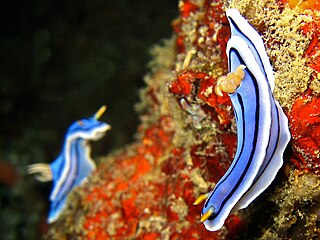
Chromodoris is a genus of very colourful sea slugs or dorid nudibranchs, marine gastropod molluscs, and the type genus of the family Chromodorididae. Within the genus Chromodoris, there are currently 101 classified species. Species within Chromodoris are commonly found in tropical and subtropical waters, living as members of reef communities and preying primarily on sponges. A molecular phylogeny of the family Chromodorididae resulted in this genus being restricted to a smaller number of species than formerly, most of which have longitudinal black lines on the mantle. Many former members of Chromodoris were transferred to Goniobranchus

Goniobranchus coi is a species of very colourful sea slug, a dorid nudibranch, a marine gastropod mollusc in the family Chromodorididae.

Goniobranchus geminus, also known as the gem sea slug, is a species of very colourful sea slug, a dorid nudibranch, a marine gastropod mollusc in the family Chromodorididae.
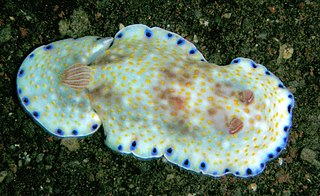
Goniobranchus aureopurpureus is a species of very colourful sea slug, a dorid nudibranch, a marine gastropod mollusk in the family Chromodorididae.
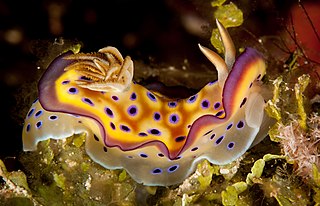
Goniobranchus kuniei is a species of very colourful sea slug, a dorid nudibranch, a marine gastropod mollusc in the family Chromodorididae.
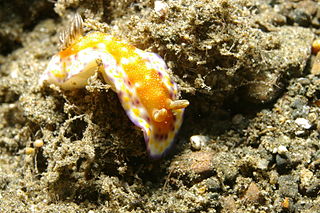
Goniobranchus collingwoodi, common name Collingwood's chromodoris, is a species of very colourful sea slug, a dorid nudibranch, a marine gastropod mollusc in the family Chromodorididae.

Goniobranchus annulatus is a species of sea slug, a very colourful dorid nudibranch, a shell-less marine gastropod mollusc in the family Chromodorididae.

Risbecia is a genus of colorful sea slugs, dorid nudibranchs, shell-less marine gastropod mollusks in the family Chromodorididae.
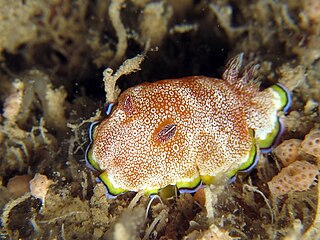
Goniobranchus albopunctatus is a species of colourful sea slug, a dorid nudibranch, a marine gastropod mollusc in the family Chromodorididae.

Goniobranchus alius is a species of colourful sea slug, a dorid nudibranch, a marine gastropod mollusc in the family Chromodorididae.
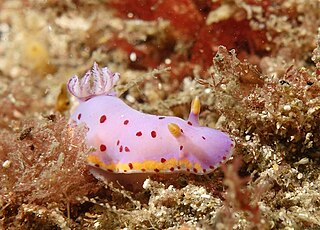
Goniobranchus loringi is a species of colourful sea slug, a dorid nudibranch, a marine gastropod mollusc in the family Chromodorididae. This species was transferred from Chromodoris to Goniobranchus in 2012.

Goniobranchus gleniei is a species of colourful sea slug, a dorid nudibranch, a marine gastropod mollusc in the family Chromodorididae.
Goniobranchus multimaculosus is a species of colourful sea slug, a dorid nudibranch, a marine gastropod mollusc in the family Chromodorididae. This species was transferred from Chromodoris to Goniobranchus in 2012.

Goniobranchus rufomaculatus is a species of colourful sea slug, a dorid nudibranch, a marine gastropod mollusc in the family Chromodorididae.

Goniobranchus tennentanus is a species of colourful sea slug in the family Chromodorididae.

Hypselodoris pulchella is a species of sea slug, a dorid nudibranch, a marine gastropod mollusk in the family Chromodorididae.
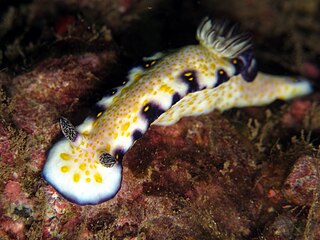
Hypselodoris imperialis is a species of sea slug, a dorid nudibranch, a marine gastropod mollusk in the family Chromodorididae.
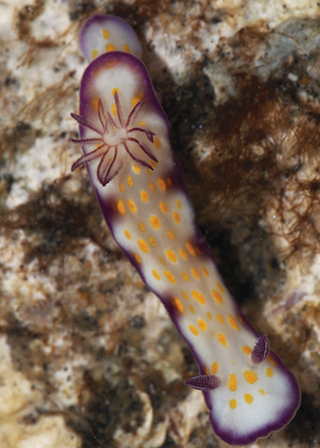
Hypselodoris ghardaqana is a species of sea slug, a dorid nudibranch, a marine gastropod mollusk in the family Chromodorididae.

Goniobranchus leopardus, is a species of colourful sea slug, a dorid nudibranch, a marine gastropod mollusc in the family Chromodorididae.























